Restoring 30% of the world's ecosystems in priority areas could stave off extinctions and absorb CO2
by PUC-Rio
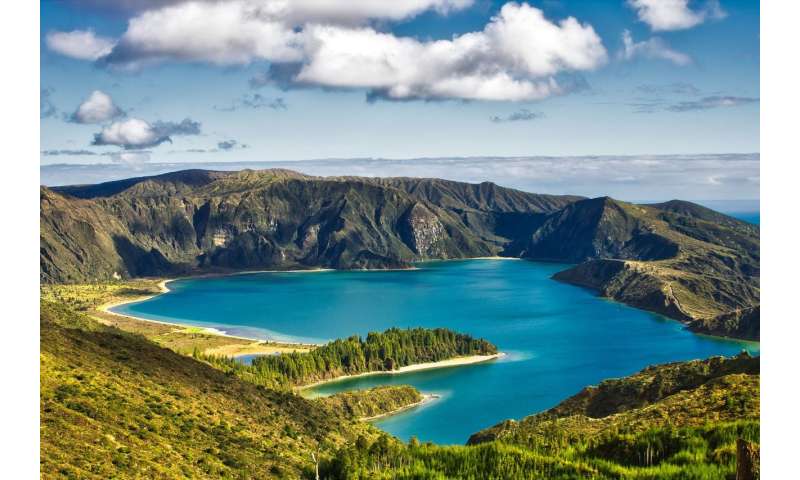
Credit: CC0 Public Domain
Returning specific ecosystems that have been replaced by farming to their natural state in all continents worldwide would rescue the majority of land-based species of mammals, amphibians and birds under threat of extinction. Such measures would also soak up more than 465 billion tons of carbon dioxide, according to a new report released today. Protecting 30% of the priority areas identified in the study, together with protecting ecosystems still in their natural form, would reduce carbon emissions equivalent to 49% of all the carbon that has built up in our atmosphere over the last two centuries. Some 27 researchers from 12 countries contributed to the report, which assesses forests, grasslands, shrublands, wetlands and arid ecosystems.
"Pushing forward on plans to return significant sweeps of nature to a natural state is critical to preventing ongoing biodiversity and climate crises from spinning out of control," said Bernardo B. N. Strassburg, the lead author of "Global priority areas for ecosystem restoration," published in Nature today. "We show that if we're smarter about where we restore nature, we can tick the climate, biodiversity and budget boxes on the world's urgent to-do list."
By identifying precisely which destroyed ecosystems worldwide should be restored to deliver biodiversity and climate benefits at a low cost without impact on agricultural production, the study is the first of its kind to provide global evidence that where restoration takes place has the most profound impact on the achievement of biodiversity, climate and food security goals. According to the study, restoration can be 13 times more cost-effective when it takes place in the highest priority locations.
In a first, the study focuses on the potential benefits of restoring both forest and non-forest ecosystems on a global scale. "Previous research has emphasized forests and tree planting, sometimes at the expense of native grasslands or other ecosystems, the destruction of which would be very detrimental for biodiversity and should be avoided. Our research shows that while reviving forests is critical for mitigating global warming and protecting biodiversity, other ecosystems also have a massive role to play," said Strassburg.
The new report in Nature builds on the U.N.'s dire warnings that we're on track to lose 1 million species in coming decades and that the world has mostly failed in its efforts to reach globally set biodiversity targets in 2020, including the goal to restore 15% of ecosystems worldwide. Nations are redoubling efforts to stave off mass extinctions in the leadup to the Convention on Biological Diversity COP15 in Kunming, China, in 2021, when a global framework to protect nature is expected to be signed. The new Nature report, which includes a co-author from the CBD, will inform the discussion around restoration and offer insight into how reviving ecosystems can help tackle multiple goals.
Using mapping technologies and a sophisticated multi-criteria optimization platform called PLANGEA, a mathematical approach that finds "slam dunk" solutions to address multiple problems, the researchers assessed 2,870 million hectares of ecosystems worldwide that have been converted to farmland. Of these, 54% were originally forests, 25% grasslands, 14% shrublands, 4% arid lands and 2% wetlands. They then evaluated these lands based on three factors, or objectives (animal habitats, carbon storage and cost-effectiveness) to determine which swathe—whether it's 5%, 15% or 30% —of lands worldwide would deliver the most benefits for biodiversity and carbon at the lowest cost when restored.
Researchers were further able to identify a global-level, multiple-benefits solution unconstrained by national boundaries that would deliver 91% of the potential benefit for biodiversity, 82% of the climate mitigation benefit, and reduce costs by 27% by focusing on areas with low implementation and opportunity costs.
When researchers looked at the benefits if the restoration were to take place at the national level—which means that each country would restore 15% of its forests—they saw a reduction in biodiversity benefits by 28% and climate benefits by 29%, a rise in costs by 52%.
"These results highlight the critical importance of international cooperation in meeting these goals. Different countries have different, complementary roles to play in meeting overarching global targets on biodiversity and climate," Strassburg said.
Responding to fears that restoring ecosystems will encroach on the land needed for crop production, researchers calculated how many ecosystems could be revived without cutting into food supplies. They found that 55%, or 1,578 million hectares, of ecosystems that had been converted to farmlands, could be restored without disrupting food production. This could be achieved through the well-planned and sustainable intensification of food production, together with a reduction in food waste and a shift away from foods such as meat and cheese, which require large amounts of land and therefore produce disproportionate greenhouse gas emissions.
"As government officials gradually refocus on global climate and biodiversity goals, our study provides them with the precise geographic information they need to make informed choices about where to restore ecosystems," said Robin Chazdon, one of the report authors.
The approach is already supporting implementation at national and local scales. It's attracting the attention of policymakers, NGOs and the private sector due to the substantial cost-benefit increase of restoration efforts. "We intend to help restoration achieve massive scales by aligning socioecological and financial interests, simultaneously increasing impacts for nature and people while improving returns and reducing risks for investors," said Strassburg.
Overall, the study provides compelling evidence to policymakers seeking affordable, efficient ways to meet United Nations goals around biodiversity, climate and, additionally, desertification, that restoration, when well-coordinated and carried out in combination with the protection of intact ecosystems and the better use of agricultural lands, is an unmatched, though currently underused, solution.
"Our results provide very strong evidence of the benefits of pursuing joint planning and implementation of climate and biodiversity solutions, which is particularly timely given the landmark meetings planned for 2021 of the associated UN conventions on climate biodiversity and land degradation," Strassburg said.
"The study also demonstrates a crucial but hitherto unexplored application of the IUCN Red List of Threatened Species," noted Thomas Brooks, chief scientist at the International Union for Conservation of Nature and a co-author of the study. "It will inform discussion next year at IUCN World Conservation Congress and fifteenth CBD Conference of the Parties regarding implementation of policy commitments, including the Bonn Challenge, the UN Decade on Ecosystem Restoration and the Sustainable Development Goals."
"A new focus on prioritizing multiple outcomes of restoring ecosystems beyond forests, and beyond country level area-based targets, calls for intensifying international cooperation to realize globally important benefits of restoring the Earth's precious ecosystems. We need to stimulate action for the sake of a healthy planet," said Chazdon.
Explore further Scientists reveal urgent solutions for boosting Protected Areas effectiveness
More information: Global priority areas for ecosystem restoration, Nature (2020). DOI: 10.1038/s41586-020-2784-9
Journal information: Nature
Provided by PUC-Rio
How being more transparent over resources helps cut carbon emissions
by Neil Vowles, University of Sussex

Credit: CC0 Public Domain
Countries that sign up to improve financial transparency over oil, gas, and mining revenues benefit from significant reductions in carbon emissions, a new study by the University of Sussex Business School reveals.
Members of the Extractive Industries Transparency Initiative (EITI) have seen their carbon emissions reduce by 13% on average between 2000 and 2014 while the world average carbon footprint per capita grew by 23% over the same period, reveals the research from the Sussex Energy Group.
Study author Professor Benjamin K. Sovacool said while the relationship between EITI membership and carbon reductions is not necessarily deterministic, the scheme allowed countries to use recovered funds no longer lost to corruption to invest in more sustainable forms of energy and other environmental practices.
More than half of countries signing up to EITI have used it to address environmental payments, highlight environmental policies, and promote better natural resource and environmental management.
Prof Sovacool, Professor of Energy Policy at the University of Sussex Business School, said: "The EITI has induced changes throughout the industry without the need for more standard tools or approaches such as carbon permits, environmental standards, timetables, and mandates.
"The initiative challenges property rights concerning information about oil, gas, and minerals; prior to its creation, data on revenues was not in the public domain. Putting it there has focused attention on companies, generated press stories, sparked dialogue with local communities, and given investors and regulators ways to measure relative performance."
The study compared the performance of the first 12 countries to attain EITI Candidacy Status against the median of 218 countries between 2000 and the most recent data available in 2020 on social, economic, and political metrics using a unique World Bank dataset.
The study found that EITI countries performed better than the global average on benchmarks related to regulatory quality, rule of law, control of corruption, foreign direct investment, and interest rates.
Researchers found correlations between EITI membership and considerable growth in energy infrastructure investment and declines in rates of extreme poverty.
While the world saw a significant deterioration in regulatory quality over the past two decades of almost 50%, EITI countries slipped by only 4%. Similarly in terms of rule of law, most countries saw a median decline in performance of 60%, but EITI countries dropped by only 5%.
However EITI countries did not see universal improvement against the world average on all metrics. They performed worse in terms of voice and accountability, political stability and violence, governmental effectiveness, energy investment, and poverty gap.
EITI countries saw a 235 % decline in political stability while globally this improved by more than 11%. Countries on average enjoyed a 226% increase in private sector investment in energy, EITI countries just 30%.
Prof Sovacool believes the EITI's limited impact on economic governance is in part due to the scheme's narrow view of transparency, covering only a minor fraction of public sector revenues and excluding wider dimensions of the sector, such as environmental impact assessments, project siting, or community relocation, are not covered.
The EITI also only focuses on government oil revenue and not government spending, where the corruption is often far worse, the study author said.
The EITI is also flawed because of its voluntary approach which means countries are not legally mandated to adhere to the principles of transparency and face no fines, criminal charges, or other sanctions for noncompliance, Prof Sovacool explained.
He added: "The EITI is an important and necessary ingredient of a dish for sustainable development in natural resource dependent countries, but it is far from a complete diet. While it may enhance economic governance and foreign direct investment, EITI membership does not lead to increased stability, reduced poverty or improved democracy.
"But our findings do suggest that, when left to their own devices, corporations and governments in resource rich countries need not always race to the bottom to lower standards and perpetuate the resource curse."
Explore further Transparency is not a panacea for the resource curse, new study finds
More information: Benjamin K. Sovacool. Is sunshine the best disinfectant? Evaluating the global effectiveness of the Extractive Industries Transparency Initiative (EITI), The Extractive Industries and Society (2020). DOI: 10.1016/j.exis.2020.09.001
Provided by University of Sussex
From hurricanes to earthquakes, space station experiment overcomes challenges
by Melissa Gaskill, NASA
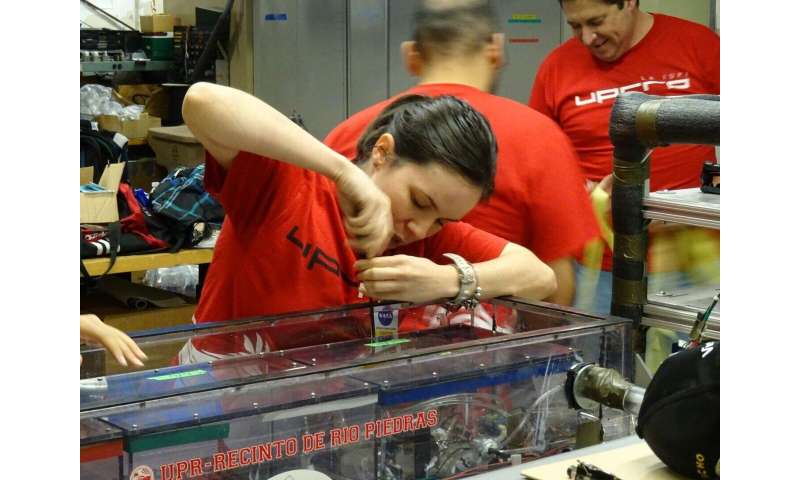
Camila Morales-Navas conducts final preparations on the Electrochemical Ammonia Removal system prior to parabolic flight testing. Credit: University of Puerto Rico
Space is hard, the saying goes, and conducting science in space presents challenges of its own. Few researchers have had to overcome hurricanes and earthquakes, though, just two of the hurdles a team of chemists in Puerto Rico faced getting their investigation to the International Space Station.
The investigation, Elucidating the Ammonia Electrochemical Oxidation Mechanism via Electrochemical Techniques at the ISS (Ammonia Electrooxidation) examines ammonia oxidation in microgravity.
Ammonia is a small molecule made up of nitrogen and hydrogen. Oxidation is a reaction involving oxygen that breaks up these molecules, producing nitrogen gas, water, and electrical energy. A compound in human urine, urea, can be converted to ammonia, making it an easily available resource. The oxidation process then can be used to produce water and energy, both critical needs on future long-term space missions, as are ways to remove ammonia from a spacecraft or habitat.
The team previously developed the Electrochemical Ammonia Removal system, or EAR, a setup similar to a battery that oxidizes ammonia electrochemically or with an electric current. They put EAR to the test on multiple parabolic flights, which provide scientists access to short-term microgravity by putting a plane into freefall. Results showed that microgravity decreased fuel cell performance 20 to 65 percent. The researchers suspected that the absence of buoyancy in microgravity caused the decrease, but needed to conduct more research to confirm that hypothesis.
"You only have about 25 seconds on parabolic flights," says principal investigator Carlos Cabrera, chemistry professor at University of Puerto Rico at Rio Piedras in San Juan. "So we wanted to use the space station to look at the process for a longer period of time."
The Ammonia Electrooxidation investigation proposal received approval from NASA in 2016 under the sponsorship of the ISS National Lab. The team first had to redesign their original flight equipment, shrinking the EAR from the size of a small refrigerator to something closer to a shoebox.
That task fell to Camila Morales-Navas, a chemistry Ph.D. student at the university who had worked on the parabolic flight tests.
Then Hurricane Maria swept across Dominica, St Croix, and Puerto Rico in September 2017. Losses totaled more than $91 billion, mostly in Puerto Rico, where nearly 3,000 people died. The category 5 storm also left the island's entire population without electricity. Five months later, a quarter of residents still lacked power.
"We had no power on campus until January 2018," says Morales-Navas. "We can figure things out on paper, but needed power to test configurations for the smaller equipment. Fortunately, we had a power generator in our lab at the Molecular Sciences Research Center, so we kept going."
More obstacles were yet to come. In late 2019 and early 2020, Puerto Rico experienced a series of earthquakes that once again took out the power, and the university closed until building inspections were completed. In March of this year, the global pandemic closed the campus and lab and in August, Tropical Storm Isaias knocked out power yet again.
"It's like extreme sports, living on this island these past three years," Morales-Navas says.
Through it all, she kept working, and by August 2020, had the smaller hardware ready. The investigation finally rode to the station on NG-14, the 14th cargo flight for Northrop Grumman's Cygnus resupply spacecraft that launched Oct. 2.
Operation of the experiment itself presents some challenges, too.
"The buoyancy-free environment of microgravity affects the reactions in the system," Morales-Navas says. "If the gaseous byproducts form as bubbles, it could block further reactions."
The researchers included repeated trials in their design so that, even if bubbles affect some of the runs, they still can collect data from the others.
"Astronauts who go to Mars will need energy," Cabrera adds. "Our objective is to bring the technology to a level of readiness for long-term missions."
Explore further Tropical Storm Isaias heads for Hispaniola with heavy rain
Provided by NASA
Which 'milk' is best for the environment? We compared dairy, nut, soy, hemp and grain milks
by Dora Marinova and Diana Bogueva, The Conversation
 Credit: Shutterstock
Credit: Shutterstock
Making eco-conscious choices at the shops can be tricky when we're presented with so many options, especially when it comes to milk. Should we buy plant-based milk, or dairy? We've looked at the evidence to help you choose.
Dairy has the biggest environmental footprint, by far
Any plant-based milk, be it made from beans, nuts or seeds, has a lighter impact than dairy when it comes to greenhouse gas emissions, as well as the use of water and land. All available studies, including systematic reviews, categorically point this out.
A 2018 study estimates dairy to be around three times more greenhouse gas emission-intensive than plant-based milks.
In the case of cow's milk, its global warming potential—measured as kilogram of carbon dioxide equivalent per liter of milk—varies between 1.14 in Australia and New Zealand to 2.50 in Africa. Compare this to the global warming potential of plant-based milks, which, on average, is just 0.42 for almond and coconut milk and 0.75 for soy milk.
What's more, dairy generally requires nine times more land than any of the plant-based alternatives. Every liter of cow's milk uses 8.9 square meters per year, compared to 0.8 for oat, 0.7 for soy, 0.5 for almond and 0.3 for rice milk.
Water use is similarly higher for cow's milk: 628 liters of water for every liter of dairy, compared to 371 for almond, 270 for rice, 48 for oat and 28 for soy milk.
Milks from nuts
Milk can be made from almost any nuts, but almond, hazelnut and coconut are proving popular. Not only do nut milks generally require smaller land areas, the trees they grow on absorb carbon and, at the end of their life, produce useful woody biomass.
Still, there are vast differences in the geographical conditions where various nut trees are grown.
Almond
California is the largest producer of almond milk in the world, followed by Australia.

Hazelnuts, and other nuts, grow on trees which require smaller land areas. Credit: Shutterstock
Compared to other plant-based milk options, its water use is much higher and largely depends on freshwater irrigation. One kernel of California almond requires 12 liters of water, which raises questions about the industrial production of these nuts in water-scarce areas.
However the biggest environmental concern with almond production in the US is the high mortality of bees, used for tree cross-pollination. This might be because the bees are exposed to pesticides, including glyphosate, and the intensive industrial agriculture which drastically transforms nature's fragile ecosystems.
In Australia, where almond orchards are smaller-scale and less industrialized, beekeepers do not experience such problems. Still, millions of bees are needed, and fires, drought, floods, smoke and heat damage can threaten their health.
Coconut
Generally, the environmental performance of coconut milk is good—coconut trees use small amounts of water and absorb carbon dioxide.
Yet as coconuts are grown only in tropical areas, the industrial production of this milk can destroy wildlife habitat. Increasing global demand for coconut milk is likely to put further pressure on the environment and wildlife, and deepen these conflicts.
Hazelnut
Hazelnut is a better option for the environment as the trees are cross-pollinated by wind which carries airborne dry pollen between neighboring plants, not bees.
Hazelnuts also grow in areas with higher rainfall around the Black Sea, Southern Europe and in North America, demanding much less water than almond trees.
Hazelnut milk is already commercially available and although its demand and production are rising, the cultivation of the bush trees is not yet subjected to intensive large-scale operations.
Milks from legumes
Soy milk has been used for millennia in China and has already an established presence in the West, but the hemp alternative is relatively new.
All legumes are nitrogen fixing. This means the bacteria in plant tissue produce nitrogen, which improves soil fertility and reduces the need for fertilizers. Legumes are also water-efficient, particularly when compared with almonds and dairy.
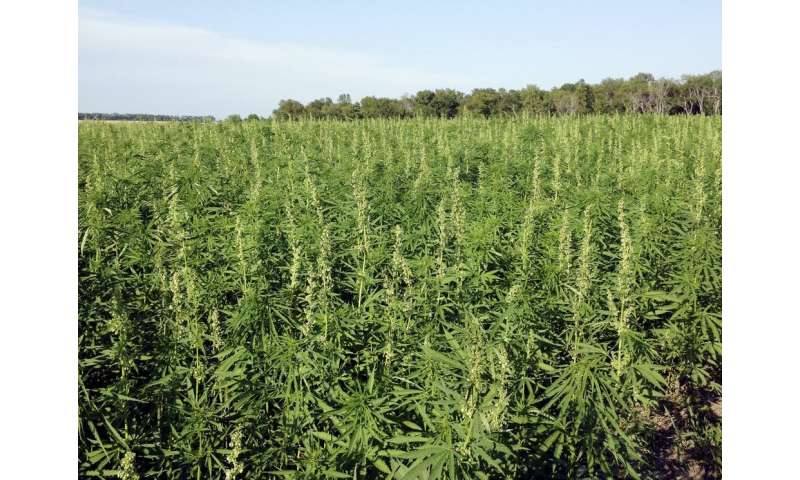 Industrial hemp growing in a field in North Dakota. Credit: North Dakota Department of Agriculture
Industrial hemp growing in a field in North Dakota. Credit: North Dakota Department of Agriculture
Soy
Soy milk has a very good environmental performance in terms of water, global warming potential and land-use.
The US and Brazil are the biggest suppliers of soybeans, and the plant is very versatile when it comes to its commercial uses, with a large share of the beans used as livestock feed.
However, a major environmental concern is the need to clear and convert large swathes of native vegetation to grow soybeans. An overall reduction in the demand for meat and animal-based foods could potentially decrease the need to produce large amounts of soybeans for animal feed, but we're yet to witness such changes.
Hemp
The environmental benefits of hemp milk make it a game-changer.
Its seeds are processed for oil and milk, but the plant itself is very versatile—all its parts can be used as construction material, textile fibers, pulp and paper or hemp-based plastics.
Its roots grow deep, which improves the soil structure and reduces the presence of fungi. It's also resistant to diseases, and it produces a lot of shade, which supresses the growth of weeds. This, in turn, cuts down the need for herbicides and pesticides.
Hemp requires more water than soy, but less than almond and dairy. Despite being one of the oldest crops used, particularly in Europe, hemp is produced in very low quantities.
Milks from grains
We can produce plant-based milk from almost any grains, but rice and oat are proving popular. However, they require more land compared with nut milks.

Oat production is mostly used to feed livestock. Credit: Kaffee Meister/Unsplash, CC BY
Rice
Rice milk has a big water footprint. More notably, it's associated with higher greenhouse gas emissions compared to the other plant-based options because methane-producing bacteria develop in the rice paddies.
In some cases, rice milk may contain unacceptable levels of arsenic. And applying fertilizers to boost yields can pollute nearby waterways.
Oat
Oat milk has been becoming increasingly popular around the world because of its overall environmental benefits.
But similar to soy, the bulk of oat production is used for livestock feed and any reduction in the demand for animal-based foods would decrease the pressure on this plant.
Currently grown in Canada and the US, most oat operations are large-scale monoculture, which means it's the only type of crop grown in a large area. This practice depletes the soil's fertility, limits the diversity of insects and increases the risk of diseases and pest infection.
Oats are also typically grown with glyphosate-based pesticides, which tarnishes its environmental credentials because it can cause glyphosate-resistant plant, animal and insect pathogens to proliferate.
The final message: diversify your choices
Organic versions of all these plant-based milks are better for the environment because they use, for example, fewer chemical fertilizers, they're free from pesticides and herbicides, and they put less pressure on the soils. Any additives, be it fortifiers, such as calcium or vitamins, flavors or additional ingredients, such as sugar, coffee or chocolate, should be taken into account separately.
Packaging is also very important to consider. Packaging contributes 45% of the global warming potential of California's almond milk. And it's worth keeping in mind that wasting milk has a much bigger environmental footprint, and questions the ethics of how humans exploit the animal world.
If, as a consumer you are trying to reduce the environmental footprint of the milk you drink, the first message is you should avoid dairy and replace it with plant-based options.
The second message is it's better to diversify the plant-based milks we use. Shifting to only one option, even if it's the most environmentally friendly one for the time being, means the market demand may potentially become overexploited.
Explore further Soy, oat, almond, rice, coconut, dairy: Which milk is best for our health?
Provided by The Conversation
This article is republished from The Conversation under a Creative Commons license. Read the original article.
New areas at risk of drinking water arsenic exposure in India
by Ben Robinson, University of Manchester
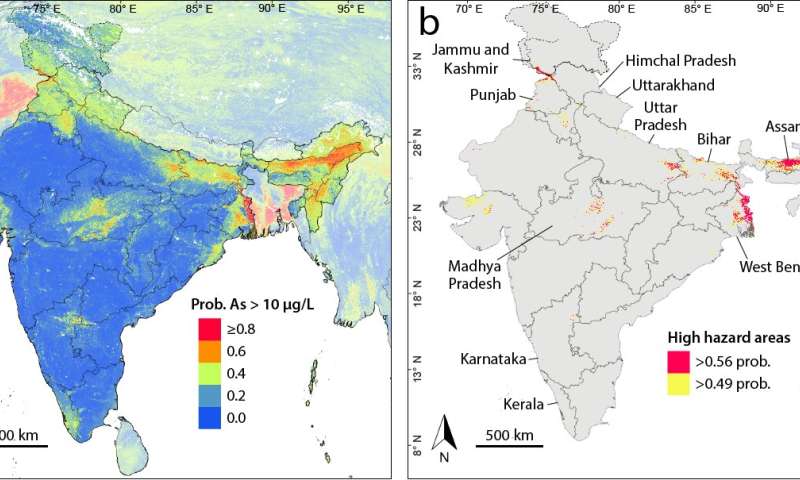
Credit: University of Manchester
Arsenic in drinking water obtained from wells is causing massive adverse health outcomes, including premature deaths from cancers and cardiovascular disease in many parts of the world and particularly in the Indian subcontinent.
Despite the enormity of this problem, most wells providing drinking water (there are at least tens of millions of them) have not been tested for arsenic, so modeling using data from those that have been tested is an important tool to help get an idea of where further high arsenic well waters are more likely to occur. Because of this, researchers have constructed prediction models for individual countries (e.g. China, Pakistan, Burkina Faso, U.S., Bangladesh, Cambodia) as well as on a regional or global scale, but curiously, to date, there had not been published a detailed model focused solely on India.
An international team involving researchers based in Manchester (UK), Patna (India) and Zurich (Switzerland) has now addressed this. Their country-specific, country-wide model for well water arsenic in India has recently been published in the International Journal for Environmental Research and Public Health.
Their model confirms the known high probability of finding hazardous high arsenic well waters in northern India in the river basins of the Ganges and Brahmaputra. What is new and particularly concerning, is that the model also finds an elevated probability of high arsenic well waters in other Indian areas, where previously arsenic hazard was generally not considered to be a major concern—so much so that in many of these areas well water arsenic is not routinely checked.
These areas include parts of south-west and central India and are mostly areas underlain by sediments and sedimentary rocks. Such occurrences are similar to those predicted by the The University of Manchester group by similar types of modeling and subsequently found elsewhere, notably in South-East Asia.
The study suggests follow up to help better define specific areas in which action is required to reduce adverse public health outcomes from drinking high arsenic well waters. The study also highlights the importance of systematic testing of hazards, not just in known high hazard areas, but also through random sampling of all wells used for drinking water.
There are known and important limitations to this kind of modeling approach. The output model can only be as good as the data upon which it is based; the model is based largely on satellite-derived data and so is less reliable for deeper wells; the model does not consider variations of well water arsenic with time. Lastly, the arsenic content of well waters is known to change massively over very short distances, so for a particular well, the model will never be a better substitute for a good chemical analysis of the water produced from that well.
Nevertheless, the model does suggest new areas in India in which follow up sampling of well water and analysis for arsenic should be done; this will help save lives in those areas.
This internationally collaboration was largely built on a joint India-UK Water Quality project FAR-GANGA (www.farganga.org ) for which co-authors Professor David Polya, a researcher at The University of Manchester, and Biswajit Charkavorty, a senior scientist at the National Institute of Hydrology, are the UK and India leads respectively.
Professor Polya said: "The model outputs are a good example of the benefits of international collaboration. The work would have been much more difficult to achieve without the joint India-UK Water Quality program project, FAR-GANGA."
Chakravorty said: "The outcome of this open-access joint Indo-UK study will help create greater awareness of hazardous arsenic distribution in wells amongst the population."
The lead author of the study was Dr. Joel Podgorski, currently a senior scientist at the Swiss Federal Institute of Aquatic Science and Technology (Eawag), but who conducted much of the study whilst a Postdoctoral Impact Research Fellow at The University of Manchester. He said: "This study demonstrates how the increasing availability of data can be used to better understand the scope of public health crises."
Ruohan Wu, a postgraduate researcher at The University of Manchester, was also part of the research team.
Explore further Study zeroes in on source of arsenic in Bengal Basin's deep wells
More information: Joel Podgorski et al. Groundwater Arsenic Distribution in India by Machine Learning Geospatial Modeling, International Journal of Environmental Research and Public Health (2020). DOI: 10.3390/ijerph17197119
Provided by University of Manchester
Our cities are full of parks, so why are we looking to golf courses for more open space?
by Wendy Walls and Jillian Walliss, The Conversation

Credit: Wendy Walls, Author provided
The recent opening of a golf course to the public in the inner north of Melbourne caused a flurry of excitement. Since then, thousands of visitors have explored the expanse of manicured rolling greens, fairways and rough. Under COVID restrictions that require Melbournians to stay within 5 km of their homes, access to a very large and beautiful open space has provided welcome relief from the well-worn tracks up and down local creeks and around local ovals.
But beyond just exploring somewhere new, the meticulously crafted landscape of the Northcote public golf course offers a rare experience in Melbourne's ever more densely developed inner suburbs.
The past six months of lockdowns have sparked many discussions about our cities and lifestyles. And the importance of local parks has come to the fore. There are issues of equity in access to parks, walkability, housing, and the measured health and well-being effects of being outdoors.
These target-driven discussions fit with the dominant planning methods of Australian cities. From walking times to tree cover targets, function has long dominated quality when defining urban open space. But this planning approach to open space significantly limits how parks are conceived.
I'm not usually a single issue voter, but I'm likely to support any @CityofDarebin candidate that commits to converting northcote golf club into a park for general use. It's open to everyone at the moment due to COVID-19 and it's pumping. @kimlecerf pic.twitter.com/fkaP2i8e72— Dr. Elliot Fishman (@ElliotFishman) September 13, 2020
Why the pressure on golf courses?
Now, as people swarm to urban parks and gardens in record numbers, we need to give open space the same status as other valued urban assets such as roads and rail. And we need to work out what government, the private sector, design professionals and the community can contribute to create better public open space over the next decade.
Returning to the Northcote golf course, a community group is lobbying for ongoing community access. It's part of a wider discussion about the future of urban golf courses across Australia. In Sydney, the Inner West Council recently voted down a hotly debated plan to give over half the Marrickville golf course to public green space. In Brisbane, the Victoria Park Golf Course is being converted to public parkland.
BREAKING: Marrickville Golf Course, the most publicly accessible course in Sydney, has been saved. The proposal to slice the course in half has been defeated. Now it's time for Royal Sydney to be opened up to dog walkers, pedestrians & picnickers as Marrickville has been for yrs. pic.twitter.com/J1vzvcXJgK— Darcy Byrne (@MayorDarcy) September 22, 2020
Urban golf courses are in the spotlight because of their rarity as large green open spaces with mature plantings. The golfing community is under pressure to justify why so much precious city space is being reserved for their sport.
This discussion masks the underlying issue of inadequate urban planning. Successive governments have failed to set aside enough open space to cater for population growth.
For decades, the planning of our cities has occurred through growth models that give priority to economic development. Missing are significant large parks—the modern equivalents of the much-loved colonial layers of the Domains in Sydney and Melbourne, Hyde Park, Royal Park or Kings Park – to offset this growth.
The issue of open space quality becomes even more pressing when we turn to the outer suburbs. Lacking access to bays and beaches, the outer suburbs no longer have the "Australian dream" of the quarter-acre block as a counterbalance. Houses are constructed gutter to gutter, cars crowd the front yards, and the local park is often a footy oval with a playground.
Time to make open space a priority
COVID and the slowing economy provide an important opportunity to rethink our models for open space.
We need to challenge the binaries of competing values—public versus private, environment versus community—that structure our cities. Our parks should not emerge through a debate over the best use of limited green space: biodiversity, community gardens, bike paths, wetlands, sport facilities, playgrounds and dog walking. None of these agendas are wrong, but there is a limit to how much space can be shared.
There are, of course, many examples of councils wanting to add more open green space. But it is important to have larger-scale and longer-term perspectives that can operate independently of local and state politics.
Global examples of open-space governance reveal shifts towards alternative funding models and public-private relationships for delivering quality, not just quantity. For example, in New York, the NGO Design Trust for Public Space works across government, community groups and the private sector to guide public space development. In Australia, the appointment of a minister for public spaces in Sydney and the Living Melbourne strategy both acknowledge the importance of overarching spatial governance.
The private sector is responsible too. Enabling large and high-quality open space across our cities means reviewing our expectations of funding and exploring new models led by the private sector. This includes not just funding construction but finding cash for ongoing park maintenance.
COVID has highlighted why the scale of open space is important. It's needed for maintaining distance between users but also for providing a sense of escape from increasing urban density, compounded by the many hours spent indoors.
It is widely recognized that an experience of nature is valuable for health and well-being. It's now time to link this directly to a diversity of high-quality park experiences.
All parks have not been created equally. Let's use this moment to determine a more ambitious future for our urban open spaces.
Explore further Income, race are associated with disparities in access to green spaces
Provided by The Conversation
This article is republished from The Conversation under a Creative Commons license. Read the original article.
Trees and lawns beat the heat
by Lisa Potter, University of Utah

The fish eye images of the sky above a park (right) and a residential area (left) around Lone Peak park in the Salt Lake Valley in Utah, United States, have different canopy coverage--the park has more open sky than in the residential areas. The canopies influence the different ground surface temperatures. Credit: Carolina Gomez-Navarro
In cities, humans replace the natural ground cover with roofs, pavement and other artificial materials that are impervious to water. These surfaces significantly change how the land absorbs and releases energy and cause the urban heat island effect, a phenomenon where developed areas get hotter than nearby rural areas. As climate change pushes many cities towards dangerous temperatures, planners are scrambling to mitigate excessive heat.
One strategy is to replace artificial surfaces with vegetation cover. In water-limited regions such as Utah, a state with one of the lowest annual rainfall rates in the United States, municipalities have to balance the benefit of cooler temperatures with using precious water for irrigation.
A new University of Utah study will make those decisions easier for the semi-arid Salt Lake Valley, the largest metropolitan area in Utah located in the northern part of the state. The researchers used 60 sensors to analyze the microclimate in five locations throughout the valley. They found that neighborhoods dominated by impervious surfaces were warmer and drier than the urban parks—up to 2 degrees warmer in both the daytime and nighttime.
"It's intuitive—we've all stood in a parking lot on a hot summer day, and you feel the heat from the ground. And when you're standing on a lawn, it's cooler," said lead author Carolina Gomez-Navarro, postdoctoral researcher at the U. "But we need to back up intuition with data to determine the best strategy for our semi-arid cities."
Gomez-Navarro and the team measured the temperature and humidity inside five parks and in their adjacent residential areas from June through August in 2016. They also analyzed how the surrounding landscape impacted air temperature. Surprisingly, they found that lawns reduced daytime and nighttime temperatures even more than trees did. While trees provide shade, lawns and turfgrass act like a swamp cooler—water moves through the plant, evaporating from tiny holes in the leaves and cooling the air.

Thermal image showing the surface temperature variation at a Sugar House park site. Credit: Carolina Gomez-Navarro
Much of the heat that builds up during the day dissipates at night. The more open the land, the better heat can escape into the atmosphere. An area with many trees acts like a greenhouse, trapping heat close to the ground. The study concluded that a mixture of dispersed trees and grass is the most effective way to cool temperatures in the Salt Lake Valley.
"Understanding how ground cover impacts temperature is crucial for city planners to weigh the benefits and costs of its landscape design," said Gomez-Navarro. "This land used to be a valley of bushes and bare soil. Any vegetation we add is going to need lots of irrigation and modify the landscape in many ways."
The paper was published on October 13, 2020 in the journal Agricultural and Forest Meteorology.
Is the grass always greener?
Gomez-Navarro focused on five parks and the adjacent neighborhoods throughout the Salt Lake Valley: Hunter (northwest), Lone Peak (southeast), Midvale City (south central), Southridge (northwest) and Sugar House (northeast). Each location had 12 sensors that measured temperature and humidity: six within the park and six in the residential areas. Gomez-Navarro analyzed ground cover in a 10-meter diameter around each sensor using satellite images to estimate the percentage of the roofs, pavement, trees or turfgrass. She found that the more turfgrass in a given area, the lower the temperature.
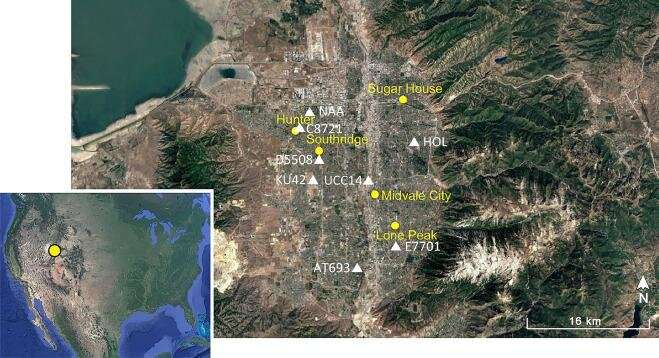
Locations of the park and residential areas included in the study. Credit: Navarro et al (2021) Agricultural and Forest Meteorology
She analyzed canopy cover by taking photos of the sky above each sensor with a fish eye lens. She used software that calculated the area that trees obstructed the sky. She found that the more open the landscape, the hotter the daytime temperature. The more canopy cover, the more shade reduced temperature.
The authors expected there to be temperature and humidity differences between the parks and neighborhoods. They were surprised, however, that turfgrass had nearly the same impact on air temperature as trees. It seems counterintuitive because of the difference between air temperature and perceived temperature. Perceived temperature is how humans feel the environment. Wind, air temperature, humidity and solar radiation all factor into how comfortable we are.
"We didn't measure human comfort in this study, but we know that the amount of solar radiation on our skin has a big impact on the perceived temperature," said Gomez-Navarro. "Even if the air temperature is the same, we feel much cooler under the shade of a tree because it blocks some of the radiation."
Smart city planning
Next, Gomez-Navarro will study how different landscapes directly affect how humans feel comfortable in their environment, and how plant cover type affect soil water loss.
"It's going to keep getting hotter and parks can be a refuge from the heat. But exactly how many degrees can they cool the air? And what should we plant to maximize this cooling?" said co-author Diane Pataki, professor of biology at the U. "It's getting easier and cheaper to measure temperature all over parks and neighborhoods, and we're going to need this information to make good decisions about future park designs."
Explore further A cooler home is right in your own back yard
More information: Carolina Gómez-Navarro et al, Effects of vegetation on the spatial and temporal variation of microclimate in the urbanized Salt Lake Valley, Agricultural and Forest Meteorology (2020). DOI: 10.1016/j.agrformet.2020.108211
Journal information: Agricultural and Forest Meteorology
Provided by University of Utah
Turning plastic waste into hydrogen gas and carbon nanotubes
by Bob Yirka , Phys.org

Credit: Unsplash/CC0 Public Domain
A team of researchers from the U.K., China, and Saudi Arabia has developed a process for converting plastic waste into hydrogen gas and carbon nanotubes. In their paper published in the journal Nature Catalysis, the group describes their process and how well it worked when tested.
Over the past several decades, plastics have been found to be a major form of pollution—in addition to the billions of tons of plastic in landfills around the world, large amounts of it has made its way into the environment, where weather and other factors break it down—the resulting microplastics have been found in lakes, rivers and streams and all of the world's oceans, harming plants and wildlife. One of the major factors driving plastic pollution is the lack of a way to recycle it. Instead, it is simply discarded. In this new effort, the researchers have found a way to recycle ordinary consumer plastics into a useable energy source and a useable carbon nanotube source.
The process involved pulverizing the plastic samples—this was done using microwaves with aluminum oxide and iron oxide serving as catalysts. Microwaves allowed for heating the catalysts without heating the plastics—instead, the plastics were heated incidentally by the catalysts. This approach prevented unwanted side reactions, which made the process more efficient.
The researchers report that the conversion process lasted just 30 to 90 seconds, and resulted in recovery of 97% of the hydrogen in the plastic. In addition, the carbon nanotubes produced were of sufficient quality for use in other applications. They note that there are currently other large-scale applications that involve the use of microwaves in commercial venues, suggesting that such use for recycling plastics might be possible. They acknowledge that they have not yet tested their approach to recycling plastics at a larger scale. They suggest the magnitude of the disaster that lies in the world's future if plastic pollution is not brought under control will drive efforts like theirs to succeed.
Explore further
Plastic bags could be 'eco-friendlier' than paper and cotton bags in cities like Singapore
by Nanyang Technological University

The team carried out a life cycle analysis of five types of bags to evaluate the environmental impacts associated with their production, distribution, transportation, waste collection, treatment, and end-of-life disposal. Credit: Nanyang Technological University
Scientists from Nanyang Technological University, Singapore (NTU Singapore) have modeled the cradle-to-grave environmental impact of using different types of shopping bags and report that in cities like Singapore, single-use plastic bags (made from high-density polyethylene plastic) have a lower environmental footprint than single-use paper and multi-use cotton bags.
Reusable plastic bags made from polypropylene non-woven plastic were the most eco-friendly option, followed by single-use plastic bags.
The model revealed that cotton and kraft paper bags have relatively bigger environmental footprints due to their greater contribution to global warming and eco-toxicity potential in their production.
However, the NTU team stressed that their model applied specifically to Singapore and might be applicable in cities such as Tokyo, Hong Kong, and Dubai. Reusable and single-use plastic bags would be a comparatively better environmental option only in these cities, due to the model's focus on densely populated metropolitan areas that have waste management structures with similar end-of-life incineration facilities.
The findings were published in the scientific Journal of Cleaner Production in August 2020.
Assistant Professor Grzegorz Lisak, Director of Residues & Resource Reclamation Centre at the Nanyang Environment and Water Institute (NEWRI), who led the research, said: "Our main message is that re-usable plastic bags are the best option, provided that they are re-used many times—over 50 times to be precise. However, one surprising conclusion is that, in our model, in a single-use case, plastic bags, if treated properly afterwards, are less environmentally detrimental than the other types of bags in this study."
"It is essential to evaluate the implications case by case for dealing with plastic waste. In a well-structured closed metropolitan waste management system with incineration treatment, using plastic bags may be the best option that is currently available, provided that there is no significant leakage of waste into the environment."
To reach their conclusions, the team carried out a life cycle analysis of five types of bags to evaluate the environmental impacts associated with their production, distribution, transportation, waste collection, treatment, and end-of-life disposal.
The research team found that the global warming potential of a single-use kraft paper bag was the highest, over 80 times that of reusable plastic bags. Single-use plastic and reusable cotton bags (reused 50 times) were calculated to have over ten times the global warming potential of reusable plastic bags (reused 50 times).
To offset the emission equivalent to equal that of the creation of one single-use plastic bag, a reusable plastic bag would need to be reused four times.
The team also observed that the relative negative environmental impacts of cotton and kraft paper bags in the model are due to their production processes that consume immense amounts of water and natural resources. Hence, improving the production methods, optimizing resource usage, and following sustainable practices could in future favor the usage of bags made from cotton and paper.
Relevance to cities and their waste reduction goals
In the case of Singapore, the team recommends the usage of reusable plastic bags to the greatest extent possible to reduce consumption of single-use plastic bags. Reprocessing single-use plastic bags would be a good policy goal to cut down on their environmental impact.
Asst Prof Lisak said that based on 2018 statistics in Singapore, reducing the single-use plastic grocery bag consumption by half could prevent over 10 million kg-CO2 equivalent emissions in a year.
Explore further
Study confirms plastics threat to south pacific seabirds
by Canterbury Museum, Canterbury Museum

Northern Royal Albatross nesting on Big Sister, north of Rekohu (Chatham Island)
Plastic gathered from remote corners of the South Pacific Ocean, including nesting areas of New Zealand albatrosses, has confirmed the global threat of plastic pollution to seabirds.
Published on 12 October in the journal Aquatic Conservation: Marine and Freshwater Ecosystems, the study looks for patterns in the plastics seabirds from around the South Pacific ingest.
It uses data gathered by Canterbury Museum Senior Curator Natural History Dr Paul Scofield and Wellington ornithologist Christopher Robertson in the late 1990s and 2000s.
"Plastic pollution is a major threat to seabird species, not just here in New Zealand but around the world," says Dr Scofield. "Knowing more about how seabirds interact with plastic might help us solve this problem in the future. At the moment, it's only getting worse."
Christopher Robertson, co-author of the study says, "One of the interesting takeaways from this study is that it shows you just how far plastic can travel in the ocean. Some of the areas where we collected the plastic are very remote. To me, that shows that this is a global issue; it's not something a single country can solve on its own."
"The samples provided by our colleagues from New Zealand allowed us to assess the patterns of seabird-plastic interactions on a larger scale, across the entire South Pacific Ocean," says the study's lead author, Valeria Hidalgo-Ruz from the Chilean Millenium Nucleus Centre of Ecology and Sustainable Management of Oceanic Islands.

Great Frigate Bird tangled in plastic, Desventuradas Islands, Chile. Credit: Diego Miranda
"The results confirm that even seabirds in one of the most remote areas of the world, the Rapa Nui (Easter Island) ecoregion, are strongly affected by this global problem, highlighting the need for urgent solutions."
In the late 1990s and 2000s, fieldworkers gathered thousands of pieces of plastic from albatross nesting sites on the Chatham Islands, Campbell Island and Taiaroa Head in Otago. The birds swallowed most of the plastic while foraging at sea and then regurgitated it at the nesting sites as they tried to feed their chicks.
Between 2003 and 2004, the team also examined plastic from the stomachs of Sooty Shearwaters killed by fishing operations around the Chatham Rise and the southeast coast of the South Island.
The study compared these plastics with similar samples from other locations around the Pacific including coastal Chile and Rapa Nui. The researchers examined the types of plastic found along with their shape, colour and density.
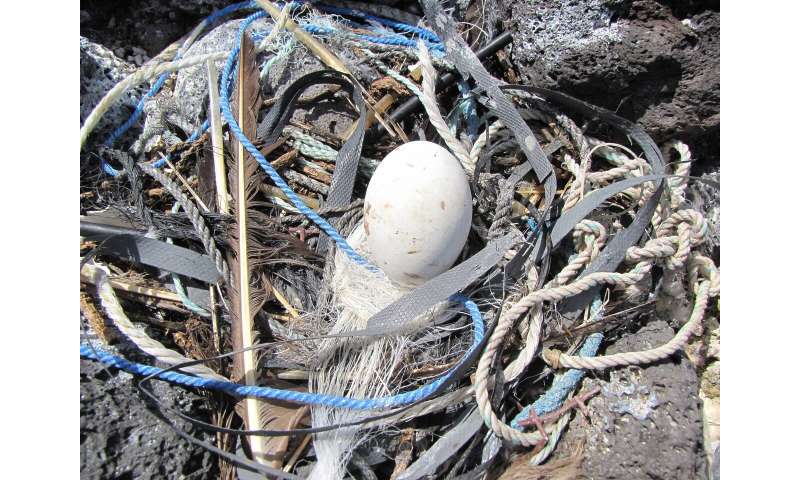 Plastics in a Great Frigate Bird nest on the Desventuradas Islands, Chile. Credit: Diego Miranda
Plastics in a Great Frigate Bird nest on the Desventuradas Islands, Chile. Credit: Diego Miranda
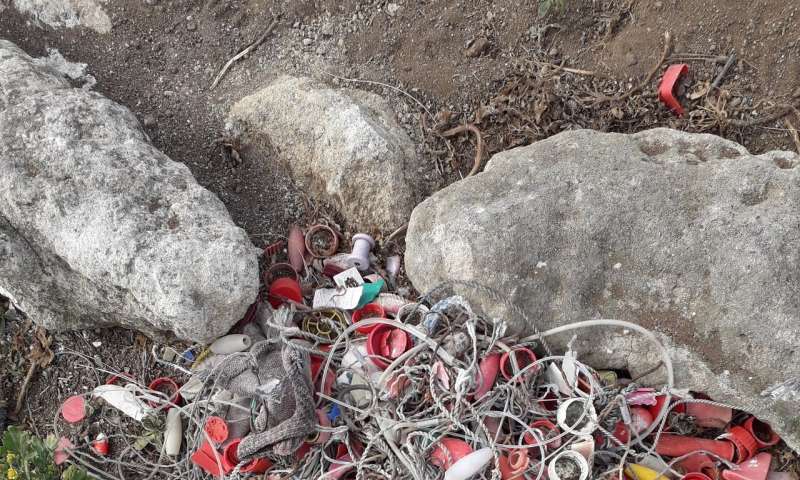 Plastics collected from albatross nesting sites on Big Sister in 2017. Credit: Mike Bell
Plastics collected from albatross nesting sites on Big Sister in 2017. Credit: Mike Bell
 Plastics in a Great Frigate Bird nest on the Desventuradas Islands, Chile. Credit: Diego Miranda
Plastics in a Great Frigate Bird nest on the Desventuradas Islands, Chile. Credit: Diego Miranda

Plastics collected from albatross nesting sites on Big Sister in 2017. Credit: Mike Bell
Albatrosses are more likely to eat brightly-coloured plastic, in particular red, green and blue. The birds probably mistake these objects for prey. The study suggests the brightly-coloured fishing gear of commercial fishing operations around the Chatham Islands and in Chile could be the source of some of the plastic found at those nesting sites.
Plastics found in the stomachs of diving seabirds like the Sooty Shearwater were dominated by hard, white/grey and round plastic items. The researchers believe most of these objects are ingested accidentally when the birds eat fish or other prey that have consumed plastic.
The ingestion of marine plastics is a major issue for seabird conservation and will affect most seabird species by 2050, according to estimates.
Explore further Seabird nests are full of discarded plastic debris
More information: Valeria Hidalgo‐Ruz et al. Factors (type, colour, density, and shape) determining the removal of marine plastic debris by seabirds from the South Pacific Ocean: Is there a pattern?, Aquatic Conservation: Marine and Freshwater Ecosystems (2020). DOI: 10.1002/aqc.3453
Provided by Canterbury Museum




 Credit: Shutterstock
Credit: Shutterstock
 Industrial hemp growing in a field in North Dakota. Credit: North Dakota Department of Agriculture
Industrial hemp growing in a field in North Dakota. Credit: North Dakota Department of Agriculture











 Plastics in a Great Frigate Bird nest on the Desventuradas Islands, Chile. Credit: Diego Miranda
Plastics in a Great Frigate Bird nest on the Desventuradas Islands, Chile. Credit: Diego Miranda Plastics collected from albatross nesting sites on Big Sister in 2017. Credit: Mike Bell
Plastics collected from albatross nesting sites on Big Sister in 2017. Credit: Mike Bell